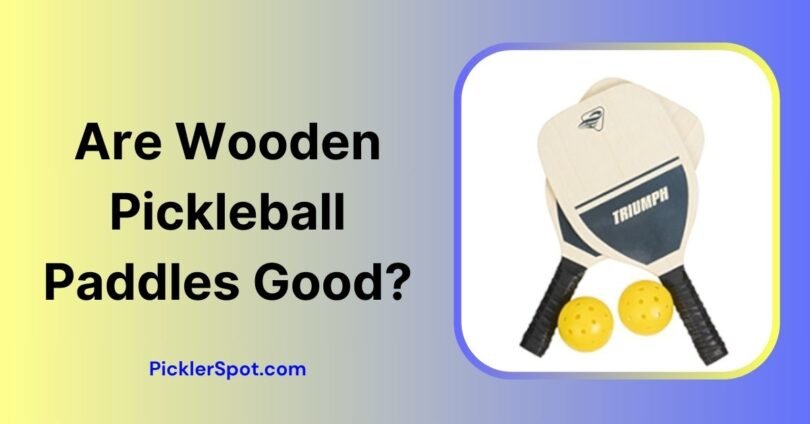Considering the fact of how actively Pickleball is played on a regular basis nowadays, it’s evident that everyone wants to jump on the bandwagon of kickstarting their Pickleball career in Professional terms.
Subsequently, it’s no wonder that the race to become better at this sport by attaining the perfect Paddle is blown out of proportion and isn’t stopping anytime soon. In fact, some curious peers of mine are wondering “Are Wooden Pickleball Paddles Good” or a complete waste of time.
In order to find out, let’s start by taking a jab on How Pickleball Paddles are made out of Wood.
How Wooden Paddles Are Made?
Even though there is a sharp decline in Pickleball Paddles being made from wood, some brands are still manufacturing it for a whole host of reasons, here is how a Paddle is created from Wood.
1. Wood Selection
Unlike other sports equipment, Pickleball Paddles are only made out of a specific kind of Wood Pulp known as either hardwood, birch, or Pine.
However, sometimes Maple tree wood is also included to create a much sturdier variety of a Paddle which exponentially increases the weight of the Paddle.
The wood pulp is often chosen from the inner cores of the trees and is carefully cherry-picked by scanning any form of faults, cracks abnormalities, or bruises, and then sliced into slabs which are then prepared for Paddle creation.
The inner core is amalgamated with poplar pulp which is considerably softer and is bonded together to provide stability and integrity to the face of the Paddle, all while ensuring the Paddle offers a natural feel that remains consistent throughout the batch of Pickleball paddles.
2. Designing The Paddle
Once the samples are chosen and bonded together, the Paddles are then subdivided on an assembly into two variants i.e. Elongated and regular sizes of Pickleball Paddles. While an equal number of variants are produced or handcrafted, they are assigned their own set of grips which are either made from Eva foam or Latex material.
This EVA foam or Latex material is then imprinted with a special honeycomb or rigged texture to provide an abrasive effect to enhance friction on the palm.
3. Reinforcement Of The Face
The Face of the paddle is reinforced with a polymer texture or resin to provide an anti-vibrational effect so that the trajectory remains intact once a ball hits the surface of the Paddle.
Furthermore, the sides of the Paddle are also lined up with an edge guard so that it doesn’t suffer from degradation whenever used consistently, especially in competitive sessions.
Lastly, UV coating or Anti-Moisture coating is applied to the face to protect it from external stimuli and enhance its effectiveness in outdoor harsh conditions.
However, keep in mind that not every “budget” Paddle has this coating applied to it and there might be variations in terms of such form of external protection.
4. Painting Or Branding
Depending on the tier, variant, and brand of the Paddle you might be getting your hands on, each Paddle is painted with its proprietary logos the series number, and its class categorization, so that consumers differentiate between them and choose their preference on the basis of their playstyle.
Are Wooden Pickleball Paddles Good?
As enticing as the whole process of creation of such Paddles might sound, you would be amazed Wooden Paddles are shunned and frowned upon in competitive leagues for a variety of reasons. These include but aren’t limited to,
1. Inconsistency Issues
I wouldn’t term Pickleball Paddles “good” or even “acceptable” due to one of its major flaws and that is its lack of consistency.
In other words, Wooden Paddles suffer from inconsistency issues which are then translated onto its horrendous sweet spot causing it to produce irregular amounts of momentum and force needed to produce an accurate trajectory.
This prevents a player from building consistent muscle memory and further increases the learning curve required to learn Pickleball especially if you are a player in your initial phases who has just started to get into this sport without prior experience.
2. Fragile Build
Wooden Paddles, even though they are made from hardwood and Maple pulp, still lack enough composition especially when used in aggressive playstyle. In fact, they suffer from tons of wear and tear during traversal especially when kept improperly in a storage bag.
Pulp is also an organic matter and is naturally biodegradable, so one way or another, your Paddle is going to suffer from disintegration faster than Paddles from Graphite or Fiberglass material which survives easily at least for half a decade.
3. Bulky & Awkward
Paddles made of wood don’t really do well in the weight department, in fact, these sorts of paddles are known to be the bulkiest amongst the bunch of other carbon composite paddles.
Subsequently, their heavier trait enforces unnecessary fatigue and strain on a player’s wrists which is the last thing an athlete wants.
In fact, one of the biggest culprits behind Tennis elbow and Carpal tunnel is swinging heavier than usual sports equipment even if it’s only meant for a single session.
So apparently, after going through all these ordeals and unnecessary headaches, it’s safe to conclude that Pickleball Paddles made from Wooden composite cannot be considered “good” at least in competitive leagues.
Are There Any Potential Advantage Of Wooden Pickleball Paddles?
At surface level, apparently, there are a couple of advantages of a Wooden Pickleball which are as follows,
1. Ideal for Practicing
If you are an individual who finds themselves alone in the court during drills, Using a wooden Pickleball paddle can work wonders since you won’t have to worry about damaging your primary Paddle and use the wooden paddle as a “side piece” to your heart’s content.
Since drills usually require you to spend eons in the court, these sessions could take a drastic toll on your equipment and eventually lead to unnecessary wear and tear.
However, you need to make sure the Paddle you buy needs to have the same weight and class characterization as your primary Paddle, so you can use it to build your hand-eye coordination and muscle memory.
2. Budget-Friendly Pick
The best part about Paddles made from Wood is that they wouldn’t cost you an arm and leg, in fact, they could be as cheap as 30 dollars and deliver almost equivalent levels of thrills if playing Pickleball for recreational purposes is your sole goal.
It can also act as an amazing tool for a rookie that you are training in their early phases as you clearly don’t want to ruin your expensive equipment when going through the preliminaries as rookie players are prone to make mistakes.
3. Eco Friendly
Everyone knows once these paddles are discarded, they can be naturally degraded or recycled which ensures the environment stays clean and green.
On the other hand, the manufacturing process also produces a lesser form of carbon footprint which eventually results in fewer toxic chemicals being exposed to the environment in the long run.
In Conclusion
The first impression is certainly the last impression. While there is nothing to worry about especially when you are rolling into the court in the early phases of your career with a wooden Paddle, it’s still wise to switch to better alternatives once you align your interest and focus towards the preliminaries.
Despite it being a budget-friendly option, the drawbacks of wooden paddle wrought’s clearly outweigh its benefits, so make sure you follow my tips mentioned above and even share this article with your peers so that everyone benefits from this knowledge equally.









